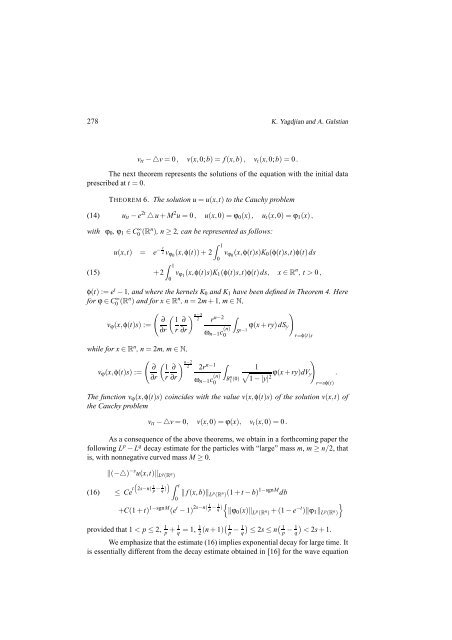278 K. Yagdjian and A. Galstianv tt −△v=0, v(x,0;b)= f(x,b), v t (x,0;b)=0.<strong>The</strong> next theorem represents the solutions of the <strong>equation</strong> with the <strong>in</strong>itial dataprescribed at t = 0.THEOREM 6. <strong>The</strong> solution u=u(x,t) to the Cauchy problem(14) u tt − e 2t △ u+M 2 u=0, u(x,0)=ϕ 0 (x), u t (x,0)=ϕ 1 (x),with ϕ 0 , ϕ 1 ∈ C ∞ 0 (Rn ), n≥2, can be represented as follows:(15)∫ 1u(x,t) = e − 2 t v ϕ0 (x,φ(t))+ 2 v ϕ0 (x,φ(t)s)K 0 (φ(t)s,t)φ(t)ds0∫ 1+2 v ϕ1 (x,φ(t)s)K 1 (φ(t)s,t)φ(t)ds, x∈R n , t > 0,0φ(t) := e t − 1, and where the kernels K 0 and K 1 have been <strong>de</strong>f<strong>in</strong>ed <strong>in</strong> <strong>The</strong>orem 4. Herefor ϕ∈ C0 ∞(Rn ) and for x∈R n , n=2m+1, m∈N,())n−3∂ 1 ∂ 2 rv ϕ (x,φ(t)s) :=∂r( n−2 ∫r ∂r ω n−1 c (n) ϕ(x+ry)dS S0n−1 yr=φ(t)swhile for x∈R n , n=2m, m∈N,( ( ))n−2∂ 1 ∂ 2 2r n−1 ∫1v ϕ (x,φ(t)s) :=√∂r r ∂r ω n−1 c (n)ϕ(x+ry)dV B n 0 1 (0) y1−|y| 2r=sφ(t)<strong>The</strong> function v ϕ (x,φ(t)s) co<strong>in</strong>ci<strong>de</strong>s with the value v(x,φ(t)s) of the solution v(x,t) ofthe Cauchy problemv tt −△v=0, v(x,0)=ϕ(x), v t (x,0)=0.As a consequence of the above theorems, we obta<strong>in</strong> <strong>in</strong> a forthcom<strong>in</strong>g paper thefollow<strong>in</strong>g L p − L q <strong>de</strong>cay estimate for the particles with “large” mass m, m≥n/2, thatis, with nonnegative curved mass M ≥ 0..(16)‖(−△) −s u(x,t)‖ L q (R n )( )∫≤ Ce t 2s−n( 1 p − q 1 t)0‖ f(x,b)‖ L p (R n )(1+ t− b) 1−sgnM db+C(1+ t) 1−sgnM (e t − 1) 2s−n( 1 p − 1 q ){ ‖ϕ 0 (x)‖ L p (R n )+(1−e −t )‖ϕ 1 ‖ L p (R n )}provi<strong>de</strong>d that 1< p≤2, 1 p + 1 q = 1, 1 2 (n+1)( 1p − 1 q)≤ 2s≤n( 1p − 1 q)< 2s+1.We emphasize that the estimate (16) implies exponential <strong>de</strong>cay for large time. Itis essentially different from the <strong>de</strong>cay estimate obta<strong>in</strong>ed <strong>in</strong> [16] for the wave <strong>equation</strong>
<strong>Kle<strong>in</strong></strong>-<strong>Gordon</strong> <strong>equation</strong> <strong>in</strong> <strong>anti</strong>-<strong>de</strong> <strong>Sitter</strong> <strong>spacetime</strong> 279<strong>in</strong> the <strong>de</strong> <strong>Sitter</strong> <strong>spacetime</strong>. This difference is caused by the strik<strong>in</strong>g difference betweenthe global geometries of the forward and backward light cones of the <strong>equation</strong> (7).<strong>The</strong> paper is organized as follows. In Section 2 we apply the fundamental solutionsto solve the Cauchy problem with the source term and with vanish<strong>in</strong>g <strong>in</strong>itialdata given at t = 0. More precisely, we give a representation formula for the solutions.In that section we also give several basic properties of the function E(x,t;x 0 ,t 0 ). InSections 3–4, we use the formulas of Section 2 to <strong>de</strong>rive and to complete the list ofrepresentation formulas for the solutions of the Cauchy problem for the case of onedimensionalspatial variable. <strong>The</strong> higher-dimensional <strong>equation</strong> with the source term isconsi<strong>de</strong>red <strong>in</strong> Section 5, where we <strong>de</strong>rive a representation formula for the solutions ofthe Cauchy problem with the source term and with vanish<strong>in</strong>g <strong>in</strong>itial data given at t = 0.In the same section this formula is used to complete the proof of <strong>The</strong>orem 6. Applicationsof all these results to the nonl<strong>in</strong>ear <strong>equation</strong>s will be done <strong>in</strong> a forthcom<strong>in</strong>gpaper.2. Application to the Cauchy problem: source term and n=1Consi<strong>de</strong>r now the Cauchy problem for the <strong>equation</strong> (7) with vanish<strong>in</strong>g <strong>in</strong>itial data (8).<strong>The</strong> coefficients of the <strong>equation</strong> (7) are <strong>in</strong><strong>de</strong>pen<strong>de</strong>nt of x, therefore the <strong>equation</strong> istranslation <strong>in</strong>variant <strong>in</strong> x that impliesE + (x,t; y,b) =E + (x−y,t;0,b). Us<strong>in</strong>g the fundamentalsolution from <strong>The</strong>orem 1 one can write the convolution(17)u(x,t) ==∫ ∞ ∫ ∞−∞ −∞∫ t ∫ ∞0db−∞E + (x,t;y,b) f(y,b)dbdyE + (x−y,t;0,b) f(y,b)dy,which is well-<strong>de</strong>f<strong>in</strong>ed s<strong>in</strong>ce supp f ⊂{t ≥ 0}. <strong>The</strong>n accord<strong>in</strong>g to the <strong>de</strong>f<strong>in</strong>ition of thedistributionE + we obta<strong>in</strong> the statement of <strong>The</strong>orem 3. Thus, <strong>The</strong>orem 3 is proven.<strong>The</strong> follow<strong>in</strong>g corollary implies the existence of an operator transform<strong>in</strong>g thesolutions of the Cauchy problem for the str<strong>in</strong>g <strong>equation</strong> to the solutions of the Cauchyproblem for the <strong>in</strong>homogeneous <strong>equation</strong> with time-<strong>de</strong>pen<strong>de</strong>nt speed of propagation.COROLLARY 1. <strong>The</strong> solution u=u(x,t) of the Cauchy problem (7)-(8) can berepresented by (13), where the functions v(x,t;τ) := 1 2( f(x+ t,τ)+ f(x− t,τ)), τ ∈[0,∞), form a one-parameter family of solutions to the Cauchy problem for the str<strong>in</strong>g<strong>equation</strong>, that is, v tt − v xx = 0, v(x,0;τ)= f(x,τ), v t (x,0;τ)=0.Proof. From the convolution (17) we <strong>de</strong>riveu(x,t) =∫ t ∫ e t −e bdb dy f(x+y,b)(4e b+t ) iM( (e t + e b ) 2 − y 2) − 1 2 −iM0 e b −e(t1× F2 + iM, 1 2 + − e t ) 2 − y 2 )iM;1;(eb (e b + e t ) 2 − y 2














